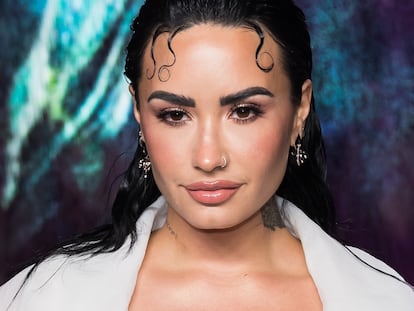A public account of agony: How Demi Lovato made her suffering her best brand
At 30 years old and about to release a rock album, the former Disney star has become one of the people’s favorite celebrities thanks to her heartbreaking honesty


Revamped, the third of Demi Lovato’s “posthumous” albums, will be released on September 15. We say “posthumous” because they (this one as well as the two that precede it, Dancing with the Devil... the Art of Starting Over and Holy Fvck) come after what the artist herself refers to as her “death and resurrection,” the opiate overdose she suffered at her Hollywood Hills home five years ago, on July 24, 2018.
In that dramatic state, Lovato suffered a heart attack and three strokes, and she is still experiencing after-effects such as a partial blindness that makes her unable to drive. She tells all about it in Dancing with the Devil, a six-part docuseries that premiered on YouTube two years ago, probably the darkest and starkest documentary on a famous woman’s shortcomings, misfortunes and tragedies that has been produced in recent years. So far it has more than 16 million views.
Revamped, the album that brings Lovato back, offers no new songs. Instead, it is a translation of ten of the most emblematic pieces from the singer’s repertoire to her new rock sensibility, starting with Sorry Not Sorry, which has been sped up to the point of delirium and features the gritty, narcotic guitar of ex-Guns N’ Roses guitarist Slash, her new creative accomplice. Fans have already had the chance to listen to three of the songs: the aforementioned Sorry Not Sorry, Heart Attack and Cool for the Summer, and they are being received with predictable enthusiasm.
Little does it matter that commentators like Rolling Stone’s Tomás Mier think that Lovato’s shift towards rock is nothing but an act of treacherous opportunism with hardly any substance. The Lovatics, one of the most fundamentalist, unwavering tribes in global fandom, are willing to buy anything their golden calf sells them. They believe in her; the unrestrained frankness with which she speaks about her life makes them feel rewarded. Her successes delight them. Her love disappointments, her emotional balance problems and her addictions make them suffer like mothers.
As Scottie Andrew explains in a CNN article, this hardcore fan base has become used to considering even her most inane statements significant and genuine, such as the recent fluctuations of her perceived sexuality and her gender identity, which have made rivers of ink flow: after successively defining herself as bisexual, pansexual and queer, in 2021 she stated that she wanted to be referred to as non-binary and changed her pronouns to “they.” Then, a few months ago, she went back to her former pronouns. The reason for all this toing and froing, as she declared on the Spout podcast, is that she has “been feeling more feminine.”

Love me, even if it hurts
There is a little-known anecdote that perfectly illustrates the peculiar way in which Demi Lovato relates to her fans since she entered the pop constellation while still a child. In September 2016, a 17-year-old follower named Vladimir Serbanescu posted on Twitter a drawing depicting the singer-actress as a sultry mermaid, with large breasts and a slim waist. In just a few hours the image had garnered 3,500 likes and more than a hundred laudatory comments from the Lovatics. Vladimir welcomed the praise with enthusiasm. Soon, however, his smile would freeze.
Given all the buzz, Lovato, who boasts about managing her own social media accounts whenever she can, intervened to state that she thought that the drawing was “gorgeous” — but that it was not her body: “Is that how my boobs should look?” The tone of the comments changed almost instantly, with Lovatics accusing Serbanescu of being insensitive, sexist and lascivious, of bastardizing Demi’s image and turning her into the object of a male fantasy. The boy ventured a timid defense: “I drew you as a mermaid, a mythological creature, [it] doesn’t mean I say that you should look like that or all girls should look like that. That’s how I imagine mermaids.” Lovato went on: “I said it’s gorgeous, sorry for saying anything at all. But it’s equally offensive that someone would change my body because mine isn’t good enough.”
That is (or at least publicly, particularly on social media) Demi Lovato. Energetic, direct, sincere. Close and empathetic when appropriate, belligerent and aggressive when she thinks that someone has crossed a line. An attentive observer, Lovato fights any display (presumed or flagrant) of misogyny; she speaks of feminism, body acceptance and queer culture; she shows vulnerability and the scars of a troubled life that has exposed her to hells like bulimia, self harm and substance abuse. And the Lovatics respond in unison, with unconditional loyalty and messianic fervor, because they feel that their idol gives herself to them body and soul, no excuses or reservations.
Forever loyal
Not all fandom communities are this devoted. Among the Smilers (the followers of Miley Cyrus) a certain discrepancy is tolerated: some love her music but deplore her image as a rebel, unruly diva. Within the Swifties (Taylor Swift’s tribe), there is a minority but very active faction — the Gaylors — that insists on taking her out of the closet against her will, and another—– the Hetlors — that demands that she reaffirm her heterosexuality over and over and conclusively disavow the former. The Barbz (the secular cult that surrounds Nicki Minaj), are also divided between skeptical gays and raving heterosexuals. Most Harry Potter fans live in a dichotomy: they adore the books, but disapprove of their author, JK Rowling, who is very active in her questioning of the advances in trans laws.
None of that happens in Lovato territory. Demi is revered, accepted and, above all, accompanied in her continuous mutations. Her most veteran fans, those who have followed her since she starred in the Camp Rock series back in 2008, when she was barely 15 years old, began supporting her when she was a Disney princess of Latin origin, in the orbit of the Jonas Brothers, a practicing Catholic, proud bearer of the purity ring that accredited her desire to remain a virgin until marriage.

Then, it became known that that angelic-looking teenager with a voice of just over four octaves, that product that seemed created to succeed in the American Bible Belt, had been the victim of a very early sexual assault (according to what she said in 2021, it happened while filming the aforementioned film, the one that contributed so much to making her a star), suffered from bulimia nervosa and had been drinking alcohol and smoking cannabis since she was 13. Shortly after, it also emerged that her relationship with Venezuelan-born actor Wilmer Valderrama, 12 years her senior, had started while she was still a minor, coinciding with the time when she began to use cocaine.
Later changes would prove even more abrupt. In 2010, at the age of 18, she entered a rehabilitation clinic for the first time. As Josh Duboff explained in Harper’s Bazaar, the trigger was that she publicly assaulted Alex Welch, one of her dancers, after having spent the whole night drinking. Her therapists stated at that time that her compulsive and erratic behavior was due to a bipolar disorder, a diagnosis that Lovato accepted for years, but with which she now disagrees, convinced that her problem is actually a severe attention deficit disorder, in addition to the anxiety, depression and schizophrenia that she is also diagnosed with.

Five minutes from death
With such baggage, and with a communication policy in which obscurity and half-truths weighed more than openness, Demi faced a transition to artistic maturity (almost) as triumphant as her stage under the umbrella of the Disney Channel. She could not slow down, as the doctors recommended after her first major collapse, because while the success of her second album, Here We Go Again (2009), had allowed her to buy a Mediterranean-style mansion in Los Angeles for her family, it also took a series of burdensome tolls.
Turned into a company and responsible for providing for her mother, stepfather and sisters, Lovato dealt with her private demons as best as she could. Between 2010 and 2012, as she now admits, she continued to take drugs without restraint, but secretly. Then came some years of relative stability and sobriety, barely disrupted by the occasional relapse. Unbroken, Demi, Confident and Tell Me You Love Me followed, increasingly successful albums that were treated kindly by the critics. She was a judge in The X Factor, in the same edition as Britney Spears, another Disney princess caught in a destructive spiral.

In November 2017, she put aside her broad-spectrum soul to try her hand at Latin pop with Échame la culpa, her successful duet with Luis Fonsi. Then, in 2018, she was finally overtaken by her demons. She lived through a nightmare year. In March, a few days after celebrating six (supposed) years without alcohol and drugs, Demi (according to her own account in Dancing with the Devil), locked herself in her mansion to drink a bottle of red wine by herself. Hours later, she ended up at a private party where for the first time she consumed methamphetamine mixed with MDMA, cocaine, marijuana, oxytocin and several liters of alcohol, a potentially lethal cocktail.
The overdose that she dodged that night would come four months later after taking fentanyl, a synthetic opioid up to 50 times stronger than heroin. One of her assistants found her lying on the floor. Paramedics came to her residence when the singer was barely “five minutes from death,” and managed to bring her back by administering naloxone with a nasal spray.

Tell me everything
If we know all these details, even the most lurid, it is because Lovato, in one of those exercises in transparency that so dazzle her fans, new and old alike, chose to tell all about them in that anthology of sordidness and misfortune that is her docuseries, something she did at the suggestion of her new agent, Scooter Braun, whom she hired shortly after being discharged after her overdose.
Braun, a 42-year-old New Yorker, had already come to the rescue of a couple of convalescents: Justin Bieber’s image and Ariana Grande’s musical career. Demi put herself in his hands and accepted the five-year plan that he devised for her: first, a long professional break to heal her wounds, regain balance and distance herself from the image of decadent toxicity associated with having suffered an opioid overdose at 25. Then, a change of musical direction (rock is not dead, says Demi Lovato), some intense social media activity and the systematic use of sincerity as a strategy.
It worked. And it did, to a large extent, because Lovato still has that splendid asset that the Lovatics have always been, that captive audience that serves as the irradiating nucleus for her global success and that has accompanied her through thick and thin since it became convinced that Demi, with all her flaws and weaknesses, would always tell the truth. This is how empires are built and consolidated in the era of new fame.
Sign up for our weekly newsletter to get more English-language news coverage from EL PAÍS USA Edition.
Tu suscripción se está usando en otro dispositivo
¿Quieres añadir otro usuario a tu suscripción?
Si continúas leyendo en este dispositivo, no se podrá leer en el otro.
FlechaTu suscripción se está usando en otro dispositivo y solo puedes acceder a EL PAÍS desde un dispositivo a la vez.
Si quieres compartir tu cuenta, cambia tu suscripción a la modalidad Premium, así podrás añadir otro usuario. Cada uno accederá con su propia cuenta de email, lo que os permitirá personalizar vuestra experiencia en EL PAÍS.
¿Tienes una suscripción de empresa? Accede aquí para contratar más cuentas.
En el caso de no saber quién está usando tu cuenta, te recomendamos cambiar tu contraseña aquí.
Si decides continuar compartiendo tu cuenta, este mensaje se mostrará en tu dispositivo y en el de la otra persona que está usando tu cuenta de forma indefinida, afectando a tu experiencia de lectura. Puedes consultar aquí los términos y condiciones de la suscripción digital.
More information
Archived In
Últimas noticias
Most viewed
- Oona Chaplin: ‘I told James Cameron that I was living in a treehouse and starting a permaculture project with a friend’
- Sinaloa Cartel war is taking its toll on Los Chapitos
- Reinhard Genzel, Nobel laureate in physics: ‘One-minute videos will never give you the truth’
- Why the price of coffee has skyrocketed: from Brazilian plantations to specialty coffee houses
- Silver prices are going crazy: This is what’s fueling the rally









































